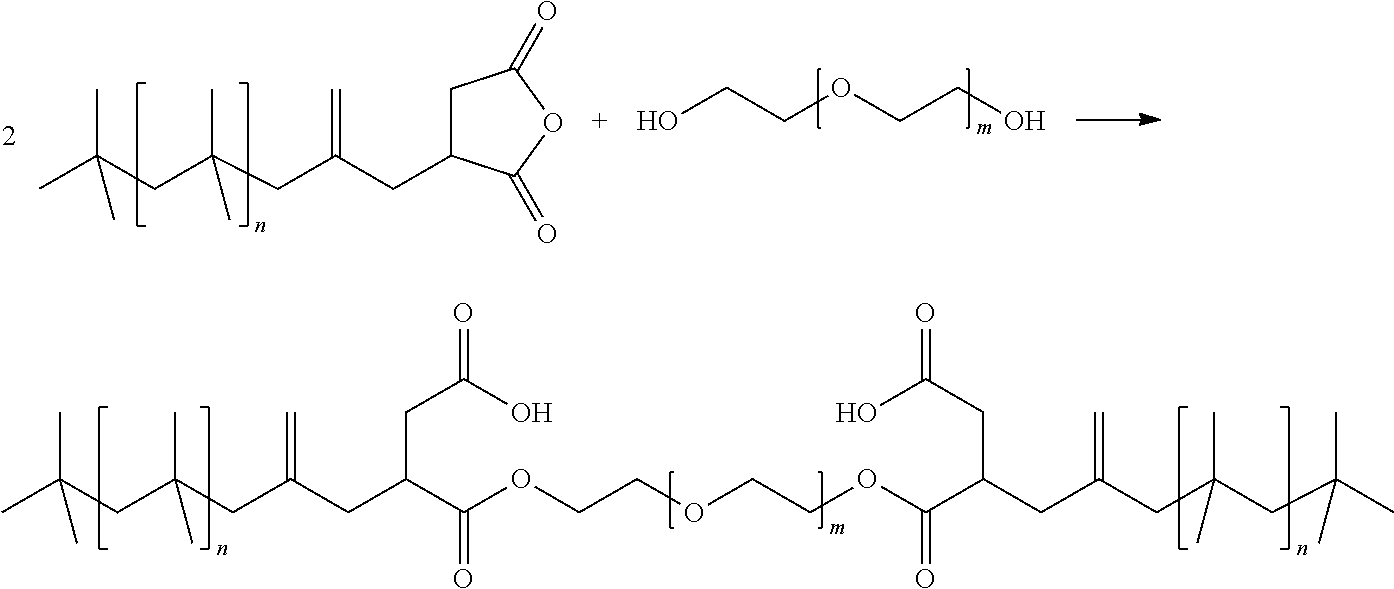Method for manufacturing transparent conducting oxides
- Summary
- Abstract
- Description
- Claims
- Application Information
AI Technical Summary
Benefits of technology
Problems solved by technology
Method used
Image
Examples
example 1
[0164]The TCO was produced by the steps listed below:[0165]1.) 175 mg of an isobutylene-ethylene oxide diblock copolymer with a number-average block length of the isobutylene block of 108 units and a number-average block length of the ethylene oxide block of 100 units were dissolved in 3.0 ml of ethanol and 1 ml of THF by means of ultrasound until a homogeneous solution was obtained.[0166]2.) 29.6 mg of a solution of antimony(III) ethoxide Sb(OC2H5)3 in 4 ml of ethanol were added to 600 mg of SnCl4 and the mixture was stirred for one hour.[0167]3.) The homogeneous solution of the polymer was added to the solution of the inorganic precursor.[0168]4.) The resulting sol was stirred for 24 h.[0169]5.) By means of dip-coating, thin layers were produced on Si wafers and glass at a constant withdrawal speed of 6 mm / s and a relative humidity of 15%.[0170]6.) After the films had been applied, they were heat treated at 100° C. for 12 h. Subsequently, the sample was heated to 200° C. at a heat...
examples 2 and 3
[0173]The preparation was effected analogously to example 1, except that the molar ratio of trivalent antimony and tetravalent tin, Sb(III) / Sn(IV), was varied according to table 1, by adding, instead of 29.6 mg, now 59.2 mg (example 2) or 78.8 mg (example 3) of a solution of antimony(III) ethoxide Sb(OC2H5)3 in 4 ml of ethanol to 600 mg of SnCl4, and stirring for one hour.
[0174]The samples from examples 1-3 all had a crystallinity of more than 90%, a porosity of approx. 35% by volume, a specific surface area in the region of 100 m2 / g, a transmission of 93-96% and a film thickness of approx. 200 nm.
[0175]The results of the measurements of the specific resistivities and of the conductivities are compiled in table 1.
[0176]
TABLE 1Properties of the Sb-doped SnO2 films.MolarSb(III) / Sn(IV)ratioSpecificSpecificSpecific areaaccording toresistivityresistivityConductivityPorosity(Krsteps 1.) andafter step 7.)after step 8.)after step 8)[% byphysisorption)Example2.) [%][Ω· cm][Ω· cm][S · cm−1]Cr...
examples 4 and 5
[0178]Preparation of Nb- and Ta-doped SnO2
[0179]
TABLE 2Example45Niobium n-propoxide Nb(OC3H7)5 [mg]37—Tantalum isopropoxide Ta(OC3H7)5 [mg]—51Molar Nb(V) or Ta(V) to Sn (IV) ratio [%]4.55.0
[0180]Solutions of the amounts of Nb(OC3H7)5 or Ta(OC3H7)5 specified in table 2 in 2 ml of ethanol were added to 550 mg of SnCl4 and then stirred for 4 h (solution of starting compound (A)). 120 mg of an isobutylene-ethylene oxide diblock copolymer with a number-average block length of the isobutylene block of 108 units and of a number-average block length of the ethylene oxide block of 100 units were dissolved in 4 ml of ethanol (concentration: 3.66% by weight) and treated with ultrasound until a homogeneous solution was obtained. The homogeneous solution of the polymer was mixed with the solution of the starting compound (A) and stirred for 19 h. A transparent sol was obtained.
[0181]By means of dip-coating, thin films were produced on Si wafers and glass substrates at a constant withdrawal speed...
PUM
| Property | Measurement | Unit |
|---|---|---|
| Temperature | aaaaa | aaaaa |
| Temperature | aaaaa | aaaaa |
| Temperature | aaaaa | aaaaa |
Abstract
Description
Claims
Application Information
 Login to View More
Login to View More - R&D
- Intellectual Property
- Life Sciences
- Materials
- Tech Scout
- Unparalleled Data Quality
- Higher Quality Content
- 60% Fewer Hallucinations
Browse by: Latest US Patents, China's latest patents, Technical Efficacy Thesaurus, Application Domain, Technology Topic, Popular Technical Reports.
© 2025 PatSnap. All rights reserved.Legal|Privacy policy|Modern Slavery Act Transparency Statement|Sitemap|About US| Contact US: help@patsnap.com


